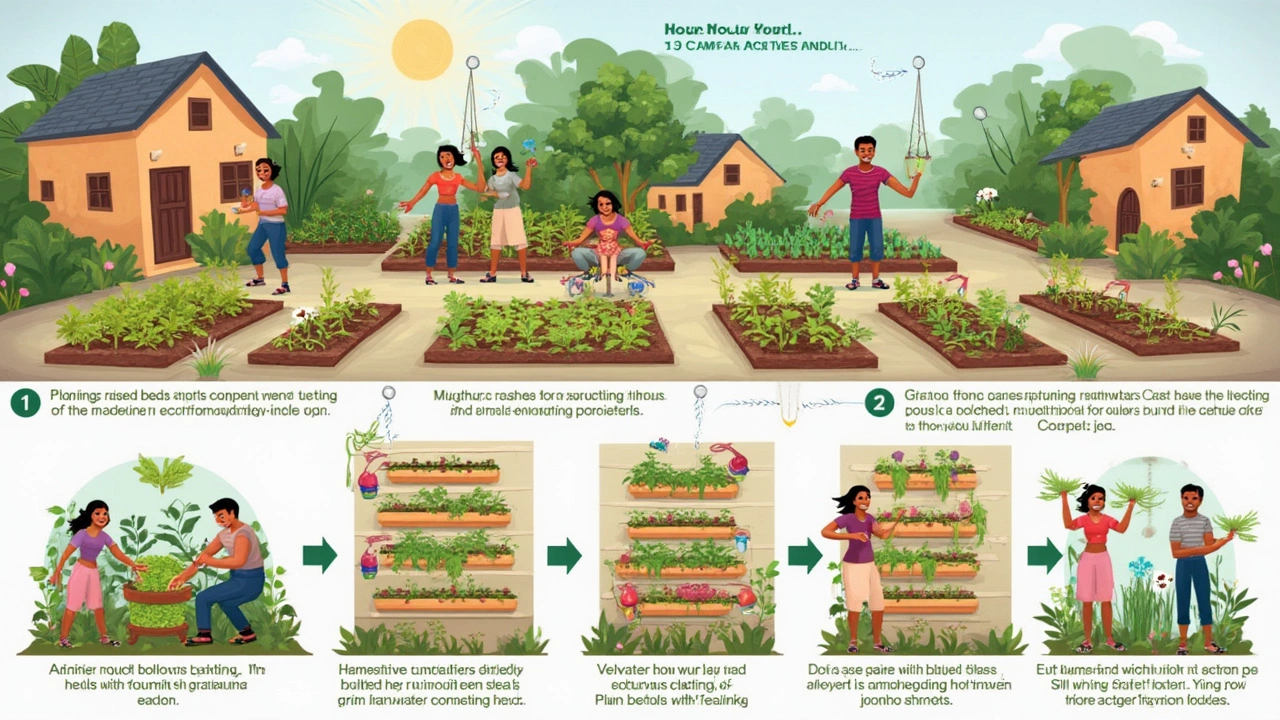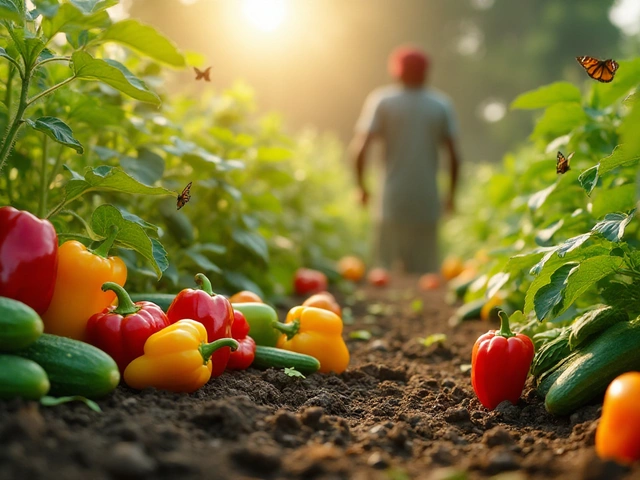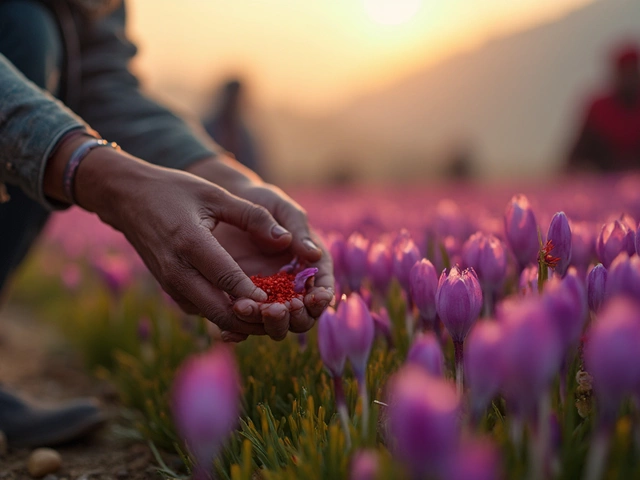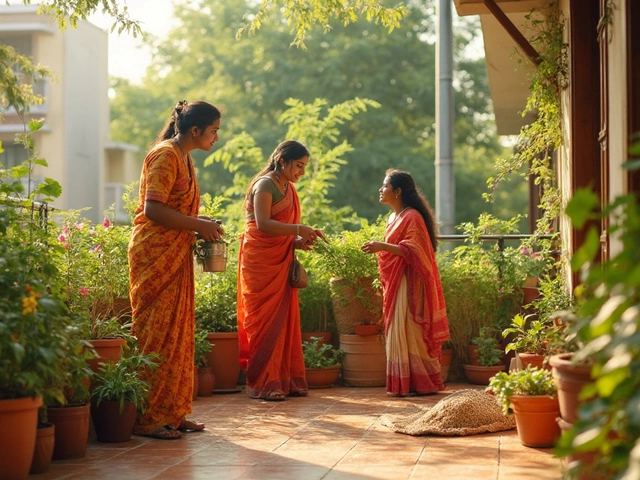Think of permaculture gardening as your backyard’s chance to join the team—nature’s team, that is. Forget fighting weeds every weekend or drenching your garden in chemicals. With permaculture, you work smart, not hard. The main idea is to copy what you see in healthy, wild places: stuff grows together, helps each other out, and the soil gets better over time, not worse.
Let’s be real: the word ‘permaculture’ can sound intimidating, but at its core, it's super practical. Want fewer pests, more food, and a garden that practically manages itself after a few seasons? That’s what you’re aiming for. You build garden beds that hold water, pick plants that benefit each other, and use way less effort and money year after year. Sound appealing? Most folks who try it wish they’d done it sooner.
- What Is Permaculture Gardening Anyway?
- Core Principles That Make It Different
- Designing Your Backyard Ecosystem
- Mistakes to Dodge and Tips to Succeed
- Cool Examples and Resources
What Is Permaculture Gardening Anyway?
Permaculture gardening isn’t just another gardening trend—it’s a big-picture way of growing food and plants that puts nature in the driver’s seat. The actual word ‘permaculture’ comes from “permanent agriculture.” It was coined back in the late 1970s by Bill Mollison and David Holmgren in Australia. They wanted to build garden setups and farms that could pretty much look after themselves, just like forests or meadows do in the wild. It’s about designing garden spaces so they’re super resilient, require less fuss, and bounce back after rough weather or pests.
Here’s what sets permaculture apart from regular gardening: instead of clear rows of plants that all need the same treatment, you copy what happens in nature. Plants, trees, bugs, and soil life all get a role, and they work together. You end up with less weeding, watering, and chemical sprays. Even better, you get healthier food and better soil over the years.
With permaculture gardening, you use stuff like mulch, compost, and companion planting so your space builds up life instead of stripping it away. Layers are a big deal—think tall trees, shrubs, ground covers, root crops, and climbing plants all working as a team. You can do it on a balcony with pots or go big with a backyard plot. The idea stays the same.
- Sustainable gardening: Focuses on low-impact growing that actually helps restore nature as it feeds you.
- Self-sufficiency: With a good permaculture setup, you use fewer outside resources like water and fertilizer.
- Boosts biodiversity: There’s a ton more insects, birds, and useful microorganisms in permaculture gardens than in traditional lawns or tilled gardens.
Check this out—some permaculture food forests, like the Beacon Food Forest in Seattle, can produce fresh food for the local community almost year-round with surprisingly little outside input.
So, if you’ve got a patch of dirt (or even just some large containers), and you’re sick of seeing your plants struggle or wasting time on garden chores, permaculture gardening is worth a try. You’re not just growing food; you’re building a living, breathing ecosystem right outside your door.
Core Principles That Make It Different
Permaculture gardening puts people and the planet first—right from the start. Unlike regular gardening that often looks at one growing season or one crop, permaculture wants the whole system to work together long term. Here’s what makes it stand out:
- Care for the Earth: The big idea here is to protect soil, water, and all living things. Every move you make—whether it’s adding mulch or planting a tree—should boost soil life and biodiversity. You don’t just grow plants; you grow everything that supports those plants.
- Care for People: This isn’t just about hugging your neighbor but making sure your garden feeds your family and maybe even helps out the local community. A permaculture setup puts real food, right where you live, into regular hands.
- Fair Share (Return of Surplus): Everything in nature shares, so your garden should, too. Got too many zucchinis? Trade with neighbors. Got compost? Dump it back into your beds. The idea is to keep excess moving, not wasting.
These ethics filter into a handful of practical principles that steer a permaculture garden:
- Observe and Interact: Before digging anything, pay attention to what your space already does—where water pools, where sunlight hits, what thrives without help.
- Use and Value Diversity: Monoculture (growing one thing everywhere) is a big no-no. In permaculture, mix veggies with flowers, throw in herbs, and let a few wild patches stick around. Diversity fends off pests and improves your soil.
- Catching and Storing Energy: Rain barrels, solar lights, compost bins—grab whatever energy, water, and nutrients come your way and hang onto them.
- Produce No Waste: It’s kind of like your grandma’s method—nothing gets tossed if it can be used. Leaves, grass clippings, even kitchen scraps get recycled into compost or mulch.
- Integrate, Don’t Segregate: Chickens in the yard? They eat bugs and fertilize at the same time. Beans growing with corn? The corn holds them up and they feed the soil. Plants and animals work better together.
Here’s a quick look at how these ideas show up in actual gardens around the world:
| Principle in Action | Result |
|---|---|
| Mixed planting (polyculture) | Fewer pests, better yields |
| Rain harvesting | Lower water bills, healthier plants |
| Permanent beds with mulch | No-till, keep soil healthy |
At its core, permaculture is just the art of stacking smart ideas so your sustainable gardening setup does as much work as you do—or sometimes even more.

Designing Your Backyard Ecosystem
Building a permaculture garden isn’t about buying fancy gear or rare plants. The big move is to start seeing your whole yard as one living system. Each part of your space has a role, from damp shady corners to sunny patches and even that odd hill you don’t know what to do with. Making smart choices up front means your garden works with you, not against you.
Here’s how the basic plan shakes out:
- Observe first—Spend a couple of weeks just watching your yard. Notice where the sun hits longest, which patches dry out first, and where water collects after rain. Permaculture folks call this the "sit and stare" phase, and it’s worth it. Bring a notebook.
- Plan your zones—Permaculture gardens use “zones” based on how often you visit each spot. Stuff you grab all the time (like herbs and salad greens) goes near your kitchen door; fruit trees or timber can live further away. This saves steps and time.
- Boost your soil—Skip bagged fertilizers. Start a compost pile and cover your soil with mulch—chopped leaves, grass clippings, or wood chips. That keeps in water and feeds worms. One study from 2023 found mulched gardens used 40% less water than bare soil. Less watering, more free time.
- Plant in layers—Copy what forests do: tall trees, shorter trees, shrubs, herbs, groundcovers, root crops, and climbers. Every layer gets more sun and water to use, blocks weeds, and stores carbon. Mixing plants together (instead of plain rows) also cuts your pest problems big time.
- Catch and use water—Why let rain run off your driveway? Use rain barrels, dig simple swales, or direct gutter water straight to fruit trees. That way, your eco-friendly system needs way less tap water.
If you want the big picture, check this out:
| Layer | Typical Plants | Role in System |
|---|---|---|
| Canopy | Fruit/Nut Trees | Shade, Structure |
| Sub-Canopy | Dwarf Trees | Production, Shelter |
| Shrub | Berries | Food, Shelter for Insects |
| Herb | Thyme, Basil | Spices, Pollinator Attractors |
| Groundcover | Strawberries | Weed Control, Mulch |
| Root | Carrots, Garlic | Soil Break-up, Food |
| Climber | Beans, Grapes | Extra Food, Vertical Space |
Designing your own sustainable gardening setup takes some effort up front, but over time, you'll notice you’re barely weeding, hardly watering, and always harvesting something. That’s the dream, right?
Mistakes to Dodge and Tips to Succeed
Let’s cut through the hype—permaculture gardening isn’t magic. It takes some know-how and you’ll probably hit a few bumps if you’re new. People often start out making the same rookie mistakes, but you don’t have to fall into those traps.
- Don’t copy and paste from random internet blueprints. Your climate and soil aren’t the same as some blogger in Tasmania. Watch your yard for where water pools, where it dries up, and which spots get the most sun. Build your layout around what’s actually happening in your space.
- Skipping the soil prep is a killer. Healthy soil is your garden’s foundation, but so many people just throw in plants and hope. Start with compost, leaves, or rotted manure. Test your soil with a cheap kit so you know what you’re working with.
- Trying to do everything at once? Big mistake. Don’t overhaul the whole yard in one season. Start with one or two zones and see what actually works before expanding. Saves money, stress, and energy.
- Ignoring mulch is like leaving money on the table. A thick layer of mulch saves water, keeps weeds in check, and feeds the soil as it breaks down.
- Using only one or two plant types? Not a great idea. Permaculture loves plant diversity. Mix veggies, herbs, and flowers, and let beneficial bugs move in. If you plant only tomatoes, every bug in town will show up for the buffet.
Now, here are the tips folks wish they’d heard earlier:
- Start small: Go for one or two raised beds or a herb spiral before recreating the Amazon rainforest.
- Stack functions: In sustainable gardening, it’s smart to pick plants that do multiple jobs. For example, nasturtiums attract pollinators and keep aphids off your beans.
- Observe, then tweak: Permaculture is all about adjusting as you go. Spend a few minutes watching where the wind blows or what’s munching your kale before jumping in with a solution.
- Water wisely: Give your garden a deep soak once a week instead of a light sprinkle every day. Roots grow deeper and plants get stronger.
Here's a quick table showing the most common blunders and better moves:
| Mistake | Better Move |
|---|---|
| Planting without soil prep | Test and feed your soil first |
| Ignoring local climate | Pick plants suited for your area |
| Growing just one crop | Diversify with multiple crops |
| Being impatient for results | Give your garden 2-3 seasons to settle in |
Keep things simple, experiment in small chunks, and remember: permaculture isn’t about perfection. It’s about learning from what actually happens in your garden and adjusting your game plan as you go.

Cool Examples and Resources
Seeing permaculture (permaculture, sustainable gardening) in real life is a game-changer. For example, the Dervaes family’s Urban Homestead in Pasadena, California, packs over 7,000 pounds of food onto a tenth of an acre—right in the middle of the city. They barely use store-bought supplies and their small space looks like a green jungle that feeds them all year round.
If you look up the Findhorn Ecovillage in Scotland, you’ll see how a community uses permaculture to clean wastewater naturally and produce food even in a tough, windy climate. Projects like these prove that eco-friendly design works in places regular gardens can’t hack it.
Want something smaller? Backyard food forests are popping up everywhere. In Florida, Rob Greenfield transformed an average front yard into a garden of wild bananas, sweet potatoes, and pigeon peas—with no lawn left. Folks in colder places layer apple trees, berry bushes, and veggies all together, letting nature do the heavy lifting. After a year or two, it’s way less maintenance than mowing a lawn.
- The Permaculture Research Institute (permaculturenews.org): Free guides, global case studies, and courses for every experience level.
- Backyard Revolution by Paul Wheaton: Packed with videos on gardening designs anyone can try, from hugelkultur beds (logs under dirt) to easy chicken setups.
- The r/Permaculture subreddit: Real people sharing their wins and fails, great for honest feedback and crowd-sourced tips.
Quick resource tip: Want to double-check if self-sufficient gardening is saving you money or water? Track a few numbers. A 2023 survey from the National Gardening Association found the average vegetable gardener saves $600 per year on groceries. That’s not just a drop in the bucket.
| Resource Name | Type | Best For |
|---|---|---|
| Permaculture Principles | Website/Blog | Clear explanations, free downloads |
| Gaia's Garden by Toby Hemenway | Book | Beginner and backyard permaculture |
| Geoff Lawton's Online Courses | Video Course | Step-by-step design action |
Whatever your space or skill level, there’s something to copy—and lots of info to help you dodge classic mistakes. These resources aren’t just talk; they’ve helped thousands grow more with less hassle. Give them a look if you want your eco-friendly garden to run smoother and feed you better.





